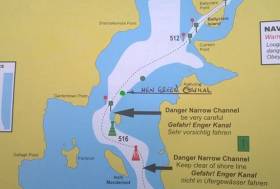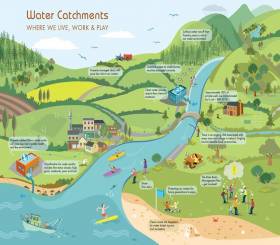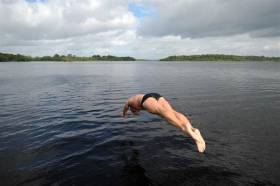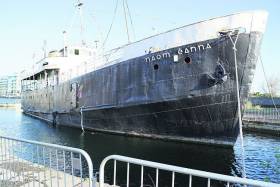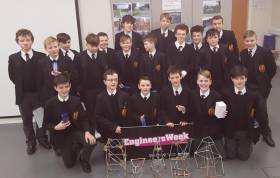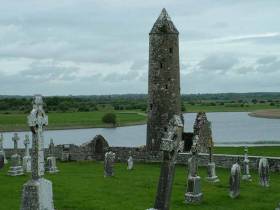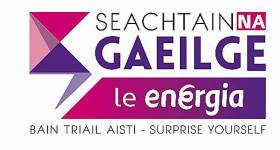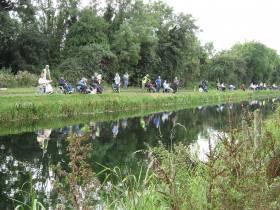Displaying items by tag: Waterways Ireland
Placement Of New Navigational Aid In Lough Ree
#InlandWaters - Waterways Ireland advises masters and users of the Shannon Navigation that a new green conical navigation aid has been placed north of Inch Macdermot Island in Lough Ree between the green perch and the green can buoy, as shown on the guide above.
The President of Ireland, Michael D. Higgins, will commemorate the Royal Canal's 200th Anniversary in the presence of Waterways Ireland, the Royal Canal Amenity Group and invited guests in Clondra, Co Longford on the 27th May 2017. The event takes place on the anniversary of the day when the canal was completed all the way to the Shannon in 1817.
The Royal Canal closed in 1950 and remained closed for 50 years. The extensive lobbying and volunteer work of the Royal Canal Amenity Group and the work of Waterways Ireland staff and their predecessors in OPW was rewarded in 2010 when the Canal was reopened to navigation.
President Higgins has been a significant supporter of the Royal Canal and the inland waterways for many years. As Minister for Arts, Heritage, Gaeltacht and the Islands, the President drove the re-vitalisation of the canal networks, including the redevelopment of the Royal Canal.
Now a vibrant recreational location, investment by Waterways Ireland and Longford County Council in conjunction with Fáilte Ireland has revitalised Richmond Harbour, Clondra, now a Blueway hub. Additional investment by local authority partners along the length of the Royal Canal has seen the upgrade of the towpath to international trails standard. Only a short section in Co Longford remains to be upgraded before the entire 144km towpath can be promoted internationally.
Dawn Livingstone Waterways Ireland Chief Executive spoke saying "I am delighted that the Royal Canal Commemorations will be honoured by the presence of President Higgins. The volunteers and staff worked so hard to reopen this navigation. They have provided a valuable service to the people of Ireland by their fight to keep this wonderful recreational amenity in public hands. As a result it is here providing opportunities for every community to freely use for work, visit, play and thrive"
Should people wish to attend the commemorations on the 27th May, they are welcome to come to the harbour. The village will be closed to traffic from early on the day and so invited guests should park in Tarmonbarry where a small coach will bring them to and from the harbour.
Attendees can expect to see the unveiling of commemorative plaques, traditional crafts and special arrivals by boat and horse & cart. Following the speeches, walkers from Irish Famine Trust at Strokestown House will set off to walk to Dublin in the steps of the 1490 people who left the Mahon Estate to walk to Dublin and the boat to America 175 years ago this week. Music will be provided by the Garda Band who will perform on the quayside.
New Waters & Communities Awards For Tidy Towns 2017
#InlandWaters - Waterways Ireland has partnered with Inland Fisheries Ireland and Local Authority Waters and Communities Office to create a new Tidy Towns Special Award for 2017.
The Waters and Communities Award and has been established to recognise communities who are taking positive steps towards raising awareness and showing appreciation of their local rivers, canals, lakes, streams, coast and ground water.
Four Regional Award winners will receive €1,000 each, with €500 each for four Regional Runner Up winners. There will also be a prize of €1,000 for the overall winner of the four regions.
All entries will be assessed by a panel of judges appointed by Inland Fisheries Ireland, Waterways Ireland and the Local Authority Waters and Communities Office.
You can apply for this award by downloading and filling out the entry form (also available as Gaeilge) and returning it before the closing date of Thursday 25 May by email at [email protected] or post to:
TidyTowns Waters and Communities Award
TidyTowns Unit
Department of Arts, Heritage, Regional, Rural & Gaeltacht Affairs
Government Offices
Ballina, Co Mayo
F26 E8N6
Couch To 5K Open Water Swim Challenge Comes To Lough Erne
#Swimming - Waterways Ireland has welcomed Maureen McCoy and Paul McCambridge’s efforts to bring their Couch to 5K Swim Challenge to Lough Erne.
The 10-week programme is designed to bring swimmers out of the pool and into the open water. The scheme will run over five fortnightly sessions from June to August 2017 and will provide swimmers with the knowledge, skills and training to ultimately complete a 5km swim event.
The coaches are Maureen McCoy, an English Channel soloist, and Paul McCambridge a North Channel relay swimmer. Both Maureen and Paul will guide swimmers through from the first outdoor swim to competing in this challenging event.
The Couch to 5K Swim Challenge is aimed at swimmers of varied levels who wish to either start swimming outdoors or improve their fitness and speed for events. The coaches have designed a programme that will challenge each swimmer and allow them to acquire new skills, no matter what their starting point.
The five fortnightly sessions will take place on Saturdays starting on 3 June, and will increase in intensity with the aim of completing a 5km swim in August.
There is a fee of £30 for participation. Register your interest at [email protected] or wildswim.wordpress.com.
Minister Urged to Back Campaign to Return Naomh Eanna to Galway
#NaomhEanna - The Minister for Transport is being urged to back a campaign to bring Naomh Eanna back to Galway, writes The Connacht Tribune.
The ship once carried passengers (and freight) between the city and Aran Islands, before being withdrawn from service in 1989. It has been lying derelict in Ringsend, Dublin for over two decades.
However, the engine room of the ship is still operational, and campaigners say if enough funds are raised, it will be possible to sail the vessel back to Galway.
Previous attempts to bring the Naomh Eanna home to Galway suggested that the ship could be a major tourist attraction for the city – by changing it into a floating museum.
The proposed project would cost in the region of half a million euro – but a recent application to Fáilte Ireland has been rejected, and campaigners feel the rejection was unfair.
The campaign group has now written to Minister Shane Ross asking him to intervene. Campaigner Sam Corbett says grant support is crucial if the Naomh Eanna is to return home to Galway.
Afloat adds that this rare surviving example of a Dublin built ship dating to 1958 had faced the prospect of been scrapped, however a campaign was launched to save her several years ago.
The disposal of the ship was to be undertaken by Waterways Ireland in a disused Georgian graving dock. This historic dry-dock (see proposal to save) is located also in Ringsend, at the Grand Canal Dock Basin from where the veteran vessel languishes.
#EngineersWeek - Demand was high for Waterways Ireland’s events during Engineers Week 2017, with 200 primary and post-primary pupils taking part in free site visits and workshops offered at the agency’s headquarters in Enniskillen.
Pupils from Florencecourt PS, Moat PS, Jones Memorial PS, St Mary's PS Mullymesker, Ballinamallard PS, St Mary's PS Enniskillen, Tattygar PS and St Joseph's College met Waterways Ireland engineering staff who led them through a series of workshops including bridge building, making floating and fixed jetties, marshmallow and straw tower challenges and understanding the Archimedes screw.
A further 130 school children attended events at Monasterevin Lock & Lifting Bridge in Kildare and Portumna Bridge in Galway.
Waterways Ireland says feedback from schools has been “very positive” with many expressing interest in attending future educational events to inspire the next generation of engineers.
Engineers Week took place from 4-10 March and is a programme of nationwide events with the aim of celebrating the world of engineering in Ireland.
The theme for 2017 was ‘Engineering Our Future’, aimed at igniting the imaginations of the next generation of engineers.
Engineers Week is co-ordinated by Engineers Ireland and is a platform to highlight engineering as a career and recognise the importance of the continually evolving engineering profession. The event is an ideal opportunity to showcase the positive contribution made by Waterways Ireland to local communities.
There are a range of engineering professionals, including civil and mechanical engineers and technicians working within Waterways Ireland.
The projects carried out on all seven of its inland waterways are wide and varied, from navigation operation, maintenance and development and structural design to project management, fleet management, development and maintenance of electro-hydraulically operated lock gates and accompanying smart card system, and much more.
Each year Waterways Ireland engineers share their expertise by giving presentations and hosting site visits with local school groups, which book up well in advance.
For the first time a St Patrick’s Day Parade has picked the Inland Waterways as the Parade theme. The IWAI has congratulated the Tullamore Parade Committee on their choice.
By selecting this theme the Parade will highlight the importance of Offaly’s Inland Waterways to the communities through which they flow. In addition to showcasing a variety of water-based activity, the Parade theme will also encourage participants to display their interpretation of the history of these Waterways. Secretary of the Parade Committee Sean O'Brien captures this feeling noting that;
“The Grand Canal has been flowing through Offaly for over 200 years and it has had a significant influence on the business, cultural, heritage and leisure life of the County and its Towns. This is a great opportunity to celebrate this impact and this great facility and we hope that many more people will use the facility over the coming years."
The IWAI has been extended a great honour with an invitation to the President John Dolan to act as Grand Marshall for the Parade. The Tullamore Parade is well-established with over 1,500 participants and up to 10,000 onlookers. While the Parade itself starts at 11.30a.m, proceedings get underway at approx. 10:30am. A flotilla will ferry the dignitaries from Bolands Lock House to the Tullamore Dew Heritage Centre. This flotilla will include members of the Tullamore Canoe Club, the Offaly Rowing Club and the IWAI Offaly Branch. Floats in the Parade will feature the IWAI Offaly Big Bolinder Engine and a variety of vessels including a 13 metre four man rowing boat, a speed boat and a powerboat.
County Offaly is a haven for Inland Waterways and includes lakes, rivers & canals. The Grand Canal, stretching from near Edenderry to Shannon Harbour, winds its way timelessly through the countryside. On reaching Shannon Harbour, one enters onto the mighty River Shannon whose waters form the natural border between Galway & Offaly. From above Meelick in the south of the County towards Athlone in the North, Offaly’s Shannon Waterways boast many treasures including the religious, cultural & historically significant site of Clonmacnoise
Waterways Ireland Keeps Eye on Prize at Erne Head
#Rowing: Waterways Ireland presented prizes to winning crews after the successful Erne Head of the River on Saturday in Enniskillen. Trinity were the best overall club at the event, while local club Enniskillen Royal Boat Club had the top junior women’s and junior men’s eights.
The chief executive of Waterways Ireland, Dawn Livingstone, said: “I am delighted to support the Erne Head of The River through the Waterways Ireland Event Programme. Sport and recreation on and along the waterways is growing strongly – 30 extra crews came to the event today. We hope to continue to work with Rowing Ireland to see that growth replicated across the waterways through 2017 and into the future.”
The Waterways Ireland head office is sited in Enniskillen.
Waterways Ireland Celebrates Seachtain Na Gaeilge
Waterways Ireland is celebrating Seachtain Na Gaeilge 2017, an international Irish language festival again this year, by offering free school tours ás gaeilge from the Waterways Ireland Centre, in Grand Canal Dock, Dublin on 10th March.
Seachtain Na Gaeilge is one of the biggest celebrations of native language and culture taking place each year in Ireland and worldwide. Gaeilgeoir Cormac MacCashin will lead tours around Grand Canal Quay enthralling school groups with his knowledge of the waterways.
Participants will hear about why we need Locks and Docks, waterways heritage, the biodiversity of the canal ecosystem and how a Lock operates, as well as an exciting treasure hunt.
Trips are fully booked for this year events but dates will be available for school tours in the Summer and Autumn terms. Enquiries can be made to [email protected].
Waterways Ireland 2017 Event Programme Seeks Applications For Events
Waterways Ireland 2017 Event Programme welcomes applications from event organisers for events taking place on or along the waterways. Formerly called the Sponsorship Programme in 2017, Waterways Ireland Event Programme is seeking applications for sustainable events and activity in waterway and waterside communities.
Taking place annually for the past 11 years the Programme has supported competitions, learning experiences, community, historical and educational events for people with and without disabilities across 1000's of communities nationwide. Involving angling, canoeing, rowing, sailing and power-sports, arts, history, drama, learning new skills, these events have most importantly been about having fun.
Sharon Lavin, Head of Marketing and Communications with Waterways Ireland stated that “The Waterways Ireland Events Programme supports 100's of community events. The new vision for the Event Programme will activate event organisers to consider how they can build in ongoing activity and sustained use of the waterways corridors into their event. Tourism & participation in recreation has a social and economic impact in waterfront communities, and events are a great way to engage communities with previously under-utilised waterways."
For the first time, applications can now be made online. The application form and guidance notes can be viewed, and completed online at https://eventsprogramme.waterwaysireland.org . Terms and conditions apply. The closing date the receipt of completed applications is 17th January 2017.
Waterways Ireland is the Recreation and Navigation Authority for the Barrow Navigation, Erne System, Grand Canal, Lower Bann Navigation, Royal Canal, Shannon-Erne Waterway and the Shannon Navigation.


























